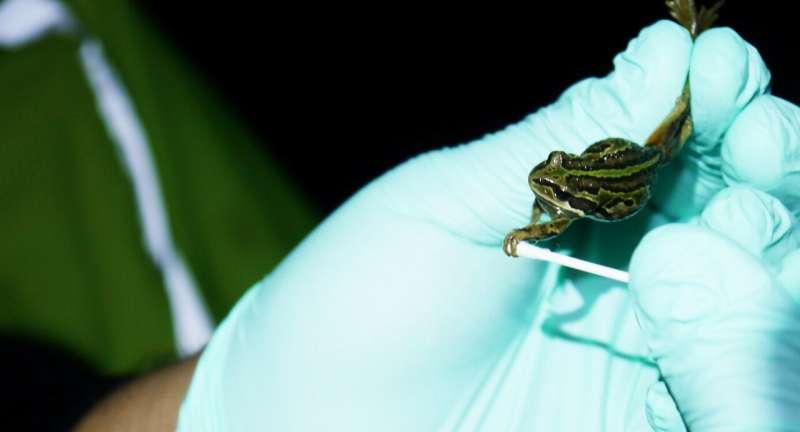Using environmental DNA to help stop frogs from croaking it

Researchers from the University of Melbourne and University of Pittsburgh, U.S. have found that diseases that affect frogs can be detected in environmental samples like soil and water, helping conservationists in their efforts to address declining amphibian populations.
Environmental DNA, or eDNA, refers to samples that can be found in the environment, that is the soil water, rather than taking direct samples from a given species. Using eDNA has strong advantages when it can be very difficult to capture and test animals, particularly ones that are critically endangered.
Dr. Laura Brannelly from the Faculty of Veterinary and Animal Sciences said that it was important to determine the use and limitations when it comes to using eDNA to detect pathogens.
"Australia has a problem with pathogens killing off many of our native frogs such as the Corroboree frog and Baw Baw frog. We really need to test different ways of anticipating pathogens in their habitats so that we can work on appropriate interventions to help protect these vulnerable populations," Dr. Brannelly said.
"As you'd imagine, it's not easy catching frogs, particularly some of the very small and functionally extinct species that we are looking for. They can hide very well in their habitat. This is why it's so important to investigate alternative methods of assessing dangers in a given environments."
The study investigated the fungus Batrachochytrium dendrobatidis (Bd). This pathogen is a leading cause of frog declines around the world and causes chytridiomycosis—an infectious and deadly disease—in frogs.
Since the 1980s, it has become increasingly evident that it is not simply environmental distribution and habitat loss than is contributing to frog declines, but the introduction of pathogens that are having devastating effects on frog populations.
The study found that when testing for a known pathogen like Bd, water samples were just as good as animal swabs when it came to detecting the presence of the pathogen. Soil samples were useful but not as accurate as water and skin swabs.
The researchers also found that eDNA did not provide accurate estimates for pathogen load (the amount of pathogen present). So, while eDNA can be used to detect the presence of a pathogen, swabbing frog populations would still be required to determine the overall risk.
"Using eDNA, we can help monitor pathogen movement across the landscape, and it has the potential to be used to predict die offs," Dr. Brannelly said.
"We've learnt that pathogens like Batrachochytrium dendrobatidis thrive in cooler conditions. Knowing this could help for future environmental interventions to help protect frogs. But the first thing that is crucial is to be able to detect the presence of that pathogen.
"In this sense using eDNA should not replace traditional swabbing, but we know that it can be a first step in monitoring sites, allowing for the identification of areas where more intensive monitoring should happen."
The technique for testing eDNA can be used more broadly for other pathogens affecting humans and agriculture. One example is that eDNA is currently being for bovine tuberculous to detect the risk of spillover from wildlife to agricultural cows.
More information: Laura A. Brannelly et al. Evaluating environmental DNA as a tool for detecting an amphibian pathogen using an optimized extraction method, Oecologia (2020). DOI: 10.1007/s00442-020-04743-4
Journal information: Oecologia
Provided by University of Melbourne



















